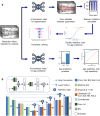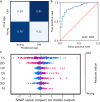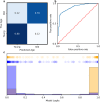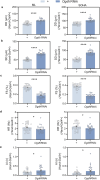Automated assessment of cardiac dynamics in aging and dilated cardiomyopathy Drosophila models using machine learning
- PMID: 38849449
- PMCID: PMC11161577
- DOI: 10.1038/s42003-024-06371-7
Automated assessment of cardiac dynamics in aging and dilated cardiomyopathy Drosophila models using machine learning
Abstract
The Drosophila model is pivotal in deciphering the pathophysiological underpinnings of various human ailments, notably aging and cardiovascular diseases. Cutting-edge imaging techniques and physiology yield vast high-resolution videos, demanding advanced analysis methods. Our platform leverages deep learning to segment optical microscopy images of Drosophila hearts, enabling the quantification of cardiac parameters in aging and dilated cardiomyopathy (DCM). Validation using experimental datasets confirms the efficacy of our aging model. We employ two innovative approaches deep-learning video classification and machine-learning based on cardiac parameters to predict fly aging, achieving accuracies of 83.3% (AUC 0.90) and 79.1%, (AUC 0.87) respectively. Moreover, we extend our deep-learning methodology to assess cardiac dysfunction associated with the knock-down of oxoglutarate dehydrogenase (OGDH), revealing its potential in studying DCM. This versatile approach promises accelerated cardiac assays for modeling various human diseases in Drosophila and holds promise for application in animal and human cardiac physiology under diverse conditions.
© 2024. The Author(s).
Conflict of interest statement
All authors declare no competing interests.
Figures







Update of
-
Automated evaluation of cardiac contractile dynamics and aging prediction using machine learning in a Drosophila model.Res Sq [Preprint]. 2023 Mar 21:rs.3.rs-2635745. doi: 10.21203/rs.3.rs-2635745/v1. Res Sq. 2023. Update in: Commun Biol. 2024 Jun 7;7(1):702. doi: 10.1038/s42003-024-06371-7. PMID: 36993511 Free PMC article. Updated. Preprint.
Similar articles
-
Automated evaluation of cardiac contractile dynamics and aging prediction using machine learning in a Drosophila model.Res Sq [Preprint]. 2023 Mar 21:rs.3.rs-2635745. doi: 10.21203/rs.3.rs-2635745/v1. Res Sq. 2023. Update in: Commun Biol. 2024 Jun 7;7(1):702. doi: 10.1038/s42003-024-06371-7. PMID: 36993511 Free PMC article. Updated. Preprint.
-
Drosophila as a model for the identification of genes causing adult human heart disease.Proc Natl Acad Sci U S A. 2006 Jan 31;103(5):1394-9. doi: 10.1073/pnas.0507359103. Epub 2006 Jan 23. Proc Natl Acad Sci U S A. 2006. PMID: 16432241 Free PMC article.
-
Pathophysiological and biochemical characterisation of an avian model of dilated cardiomyopathy: comparison to findings in human dilated cardiomyopathy.Cardiovasc Res. 1993 Dec;27(12):2212-21. doi: 10.1093/cvr/27.12.2212. Cardiovasc Res. 1993. PMID: 8313431
-
Drosophila as a model to study cardiac aging.Exp Gerontol. 2011 May;46(5):326-30. doi: 10.1016/j.exger.2010.11.035. Epub 2010 Dec 3. Exp Gerontol. 2011. PMID: 21130861 Free PMC article. Review.
-
As time flies by: Investigating cardiac aging in the short-lived Drosophila model.Biochim Biophys Acta Mol Basis Dis. 2019 Jul 1;1865(7):1831-1844. doi: 10.1016/j.bbadis.2018.11.010. Epub 2018 Nov 27. Biochim Biophys Acta Mol Basis Dis. 2019. PMID: 30496794 Free PMC article. Review.
References
MeSH terms
Grants and funding
LinkOut - more resources
Full Text Sources
Medical
Molecular Biology Databases
Miscellaneous

